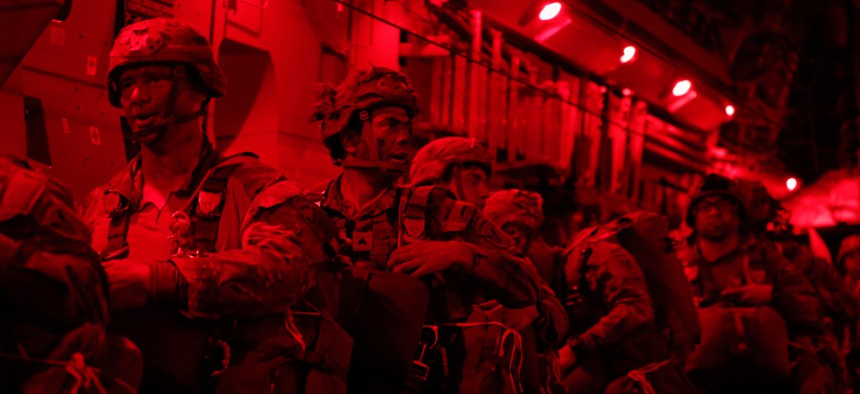
U.S. Army infantryman from the 3rd Battalion, 509th Parachute Infantry Regiment (Airborne), prepare for jump while flying to landing zone in Townsville, Australia on August 1, 2023, during Talisman Sabre 23. U.S. Army / Staff Sgt. Jessica Elbouab
US Army’s Pacific corps will invite more allies to join groundbreaking comms platform
Mission partner environment, which debuted with Australia, will be extended to other exercise partners in the coming year.
The Army’s First Corps thinks it has a way around the thorny problems of coordinating with far-flung allies and partners who don’t share the same classification system.
It’s called the mission partner environment—a digital communications platform that is “absolutely foundational” to how the corps will operate in the Pacific, said Lt. Gen. Xavier Brunson, the corps’ commanding general.
Communicating with partners and allies used to mean having separate networks in different rooms or buildings. But in conflict, getting information quickly to the right person is critical. So First Corps built the MPE, which runs through the Combined Joint Network Operations Security Center. It’s a collection of common services for chat, voice, video, position, location, indication, common operating picture, and file-sharing that allows users to access only the information they are cleared to see.
“In the past, we've done that with walls, but imagine how powerful the construct is when we're all in the same room. There's a sense of verisimilitude that happens where I'm a part of this team. Now, that makes us better partners,” he said.
Col. Rett Burroughs, First Corps’ chief information officer, is in charge of making sure the platform runs smoothly, with a network to support it.
“We were just at Talisman Sabre with the Australians…and we were able to leave that network in place—and it's still on, it's going to be on in perpetuity. We're going to do the same thing when we go to Japan,” for the Yaka Samura exercise, Burroughs told Defense One. “And we're going to be able to connect the Australians and the Japanese and us together for the first time. And then we're going to continue this on in Thailand in Cobra Gold next February. And we’re going to do it again in the Philippines in the summer.”
Ultimately, the goal is to bring the platform to every partner nation in the Pacific as part of a broader plan to strengthen partnerships and tactical operations centers that can work at all times.
Burroughs said the mission partner environment uses continuous monitoring to check for cyber threats and vulnerabilities. The corps is also testing an identity management solution that lets users from partner nations use “one of my computers…based off of their credentials,” instead of gating information behind classification levels, he said.
That means if a partner or ally’s device is damaged or malfunctioning, they could log onto an Army computer with their credentials and still only see what they were cleared to see.
“Do we need to have all of this classified stuff to fight? No, not necessarily right. But what does the warfighter need? What is the data that is important that the warfighter, the commander needs to make a decision? And that's what we really focused on,” Burroughs said.
The platform is intended to provide the constant contact that is key to allied relationships,, Brunson said.
“We don't have a NATO in the region. But we do have great relationships, nation to nation to nation. And that's power, because people are continuing to show,” he said.
The U.S. doesn’t have a status-of-forces agreement with many of the countries in the Pacific region. But through a “lighter touch” and existing military exercise frameworks, the corps can “be in that nation without overtaxing their ability to provide force on the ground,” Brunson said. “We exist in the footprint that our partners have…which in effect says you have everything that we need to operate. And we're going to fall in and become a part of the unit that you have.”
And the mission partner environment is integral to that.
“As we continue to sew folks together, I think what we're going to end up with is we're going to have this mission partner environment everywhere to where everybody, even when you're at home in ‘rest,’ you're still tied to this network of friends, partners and allies. And when we can do that, when we get this thing set up all the way, we will always have an eye in the region at the corps level,” Brunson said.




